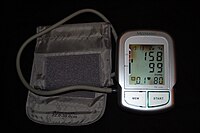
Photo from wikipedia
Esophageal pressure (Pes) monitoring is a minimally invasive advanced respiratory monitoring method with the potential to guide ventilation support management. Pes monitoring enables the separation of lung and chest wall… Click to show full abstract
Esophageal pressure (Pes) monitoring is a minimally invasive advanced respiratory monitoring method with the potential to guide ventilation support management. Pes monitoring enables the separation of lung and chest wall mechanics and estimation of transpulmonary pressure, which is recognized as an important risk factor for lung injury during both spontaneous breathing and mechanical ventilation. Appropriate balloon positioning, calibration, and measurement techniques are important to avoid inaccurate results. Both the approach of using absolute expiratory Pes values and the approach based on tidal Pes difference have shown promising results for ventilation adjustments, with the potential to decrease the risk of ventilator-induced lung injury.
Journal Title: Journal of Personalized Medicine
Year Published: 2023
Link to full text (if available)
Share on Social Media: Sign Up to like & get
recommendations!